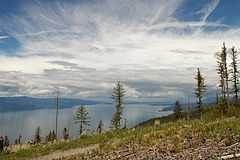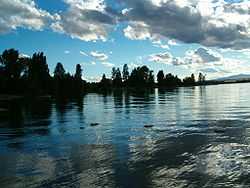Flathead Lake
| Flathead Lake | |
|---|---|
 | |
| Location | Lake / Flathead counties, Montana, USA |
| Coordinates | 47°54′6″N 114°6′15″W / 47.90167°N 114.10417°WCoordinates: 47°54′6″N 114°6′15″W / 47.90167°N 114.10417°W |
| Type | Moraine-dammed lake |
| Primary inflows |
Flathead River Swan River |
| Primary outflows | Flathead River |
| Catchment area | 8,587 sq mi (22,240 km2) |
| Basin countries | United States |
| Max. length | 27.3 mi (43.9 km)[1] |
| Max. width | 15.5 mi (24.9 km)[1] |
| Surface area | 197 sq mi (510 km2)[2] |
| Average depth | 164.7 ft (50.2 m) |
| Max. depth | 370.7 ft (113.0 m)[1] |
| Water volume | 5.56 cu mi (23.2 km3)[1] |
| Residence time | 3.4 years |
| Shore length1 | 161.4 mi (259.7 km)[1] |
| Surface elevation | 2,894 ft (882 m) |
| Islands | Wild Horse Island, Cromwell, Bird, Bull, Melita, Shelter, Cedar, Mother-in-Law, Dream, etc. |
| 1 Shore length is not a well-defined measure. | |
Flathead Lake (Salish: člq̓etkʷ [3]) is the largest natural freshwater lake west of the Mississippi River in the contiguous United States,[4][5] taking Red Lake (Minnesota) and Lake of the Woods to be north of the Mississippi River, rather than west of the river. With a surface area of between 191.5 sq mi (496 km2)[1] and 197 sq mi (510 km2), Flathead Lake is slightly larger than Lake Tahoe.[2] The lake is a remnant of the ancient, massive glacial dammed lake, Lake Missoula of the era of the last interglacial.[6] Flathead Lake is 27.3 mi (43.9 km) long and up to 15.5 mi (24.9 km) wide. Flathead lake has a maximum depth of 370.7 ft (113.0 m),[1] and an average of 164.7 ft (50.2 m). This makes Flathead lake deeper than the average depths of the Yellow Sea or the Persian Gulf. Polson Bay, at the lake's outlet was raised 10 ft (3.0 m) by Kerr Dam.[7] It is one of the cleanest in the populated world for its size and type.[8]
Geography
Located in the northwest corner of the state of Montana, 7 miles (11 km) south of Kalispell, it is approximately 30 miles (50 km) long and 16 miles (25 km) wide, covering 191.5 square miles (495.9 km²), making it approximate in size to Minnesota's Mille Lacs Lake and half the area of San Francisco Bay (main bay). Flathead Lake is 30 miles (48 km) southwest of Glacier National Park and is flanked by two scenic highways, which wind along its curving shoreline. On the west side is U.S. Route 93, and on the east, is Route 35.[citation needed]

The lake is bordered on its eastern shore by the Mission Mountains and on the west by the Salish Mountains. The Flathead valley was formed by the glacial damming of the Flathead River and sustains a remarkably mild climate for a region located this far north and inland; the Pacific Ocean is almost 400 miles to the west. The mild climate allows for cherry orchards on the east shore and vineyards for wine production on the west shore. There are also apple, pear, and plum orchards around the lake as well as vegetable, hay, honey, nursery tree, Christmas tree, sod/turf, and wheat production bordering or near the lake.[citation needed]
History
Once known as "Salish Lake", this body of water takes its name from the Salish (Flathead) Indians who live at the southern end of the lake on the Flathead Indian Reservation. Kerr Dam, near Polson, regulates the lake's water level and provides hydroelectric power and water for irrigation. The lake has an irregularly-shaped shoreline and a dozen small islands, the largest of which is a state park called Wild Horse Island. These islands cover 5.5 square miles (14.2 square kilometers). Besides the Flathead River, the Swan River (known also as the Bigfork River where it enters the lake) is the lake's other major tributary. The lake is inhabited by the native bull trout and cutthroat trout, as well as the non-native lake trout, yellow perch, and lake whitefish. It is also reportedly inhabited by the infamous Flathead Lake Monster.[citation needed]
The opossum shrimp, Mysis diluviana, invaded Flathead Lake. Lake trout had been introduced 80 years prior but remained at low densities until nonnative Mysis became established. The bottom-dwelling mysids eliminated a recruitment bottleneck for lake trout by providing a deep water source of food where little was available previously. Lake trout subsequently flourished on mysids and this voracious piscivore now dominates the lake fishery; formerly abundant kokanee were extirpated, and native bull and westslope cutthroat trout are imperiled. Predation by Mysis shifted zooplankton and phytoplankton community size structure. Bayesian change point analysis of primary productivity (27-y time series) showed a significant step increase of 55 mg C m−2 d−1 (i.e., 21% rise) concurrent with the mysid invasion, but little trend before or after despite increasing nutrient loading. Mysis facilitated predation by lake trout and indirectly caused the collapse of kokanee, redirecting energy flow through the ecosystem that would otherwise have been available to other top predators (bald eagles).[9]
Geology
Flathead Lake lies at the southern end of a geological feature called the Rocky Mountain Trench. The trench, which formed with the Rocky Mountains extends north into the southern Yukon as a straight, steep valley, which also holds the headwaters of the Columbia River. During the last ice age this trench was filled by an enormous glacier. As the glacier moved southward it carved out the trench. Present day Polson, Montana marks the southernmost extent of the glacier during the last ice age and thus is the site of the glacier's terminal moraine.[citation needed]

The large size of the Polson Moraine indicates that the glacier stalled here for several years before retreating. As the climate warmed, a portion of the glacier in the Mission Valley receded more slowly than the main body, which kept the lake basin from being filled with sediment. Eventually this ice also melted, forming a lake behind the moraine. Once the water reached the top of this moraine dam, it began to cut a channel through it. Most moraine dammed lakes drain quickly because water cuts entirely through the moraine. However, Flathead Lake remains because a bedrock hill buried underneath the Polson Moraine prevented the moraine from being completely cut through so the meltwater never completely drained.[citation needed]
At one time, probably when the valley was partially filled by a glacier, the level of Flathead Lake was about 500 feet (150 m) higher and drained through the valley west of Elmo, Montana which is at the end of Big Arm Bay, bottom center in the aerial photo above. Water carved out a wide, flat-bottomed pass with a deeper, narrow channel at the south edge of the pass. The deeper channel and traces of the dry riverbed are still visible from Route 28.[citation needed]
Panorama
.JPG)
Notes
- ↑ 1.0 1.1 1.2 1.3 1.4 1.5 1.6 About Flathead Head, Flathead Lake Biological Station, The University of Montana
- ↑ 2.0 2.1 Van der Leeden, Frits; Fred Louis Troise, David Keith Todd (1990). The Water Encyclopedia. CRC Press. p. 185. ISBN 978-0-87371-120-3.
- ↑ Tachini, Pete (2010). Seliš nyoʻnuntn, Medicine for the Salish language : English to Salish translation dictionary (2nd ed.). Pablo, MT: Salish Kootenai College Press. p. 242. ISBN 9781934594063.
- ↑ NPS Archeology Program: State submerged Resource Laws, National Park Service
- ↑ New strategies for America's watersheds, National Research Council (U.S.). Committee on Watershed Management
- ↑ http://vulcan.wr.usgs.gov/Glossary/Glaciers/IceSheets/lake_missoula_FAQ.html
- ↑ Kerr Dam, PPL Montana
- ↑ Flathead Lake & Watershed Overview, Flathead Lakers
- ↑ Long-term Effects of a Trophic Cascade in a Large Lake Ecosystem, PNAS
References
- Alt, David. "The Making of Flathead Lake" in Profiles of Montana Geology: A layman's guide to the Treasure State. Butte, MT: Montana Bureau of Mines and Geology, 1984
External links
| Wikimedia Commons has media related to Flathead Lake. |